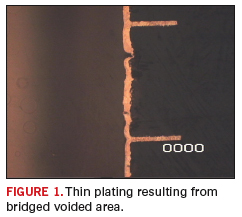
The best defense against voids is to understand the processes that can cause the defect.
In this edition of Positive Plating, we will discuss voids that are directly attriuted to the electroless deposition process.
Voids
in the electroless copper deposit can be caused by a variety of
reasons, but incorrect or improper maintenance of chemical
concentrations or operating parameters are most often the culprits.
Assuming that the desmear operation and drilling are within
specifications, the next step is to concentrate on the electroless
copper process itself. It is important to recognize that the PTH
process is an integrated operation. This means that the various process
steps are interdependent on each other. For example, the
cleaner-conditioner step influences the degree of catalyst adsorption,
which in turn influences copper deposition. Thus, one can still produce
voids but not necessarily because of the electroless copper solution
itself.
After the desmear operation, the next step is
to clean and condition the holes. The cleaner conditioner functions as
a super wetting agent that promotes catalyst adsorption onto the glass
and resin of the hole wall. The key is to avoid incomplete conditioning
of the holes, but not over-condition due to extended dwell times, poor
rinsing or a higher than normal concentration of the conditioning
chemistry.
The cleaner conditioner is generally a
mildly alkaline solution containing wetting agents. These wetting
agents are often formulated with cationic surfactants or
polyelectrolytes that aid in the adsorption process by neutralizing the
negative charges on the hole wall particularly the glass rich areas.
The supplier must formulate these conditioners so as to form a
monolayer of conditioner on the hole wall, as opposed to the multilayer
coatings that some cationic surfactants produce. Generally,
insufficient conditioning will lead to poor catalyst adsorption,
particularly on the glass fibers, which leads to poor electroless
copper deposition.
The catalyst provides the medium
that will permit the actual deposition of the electroless copper onto
the hole wall. The activator is a colloidal catalytic solution formed
by the admixture of palladium chloride salts, a stannous salt in molar
excess of the catalytic metal salt (palladium) in an acidic medium. The
tin is required to keep the palladium in its active state and prevent
the precious metal from precipitating, which would render the catalyst
inactive.
Insufficient amounts of catalyst will
reduce the amount of copper deposited in the hole. This can lead to
either voids, reduced electroless copper plating thickness, or both.
Other key parameters to monitor are:
- Catalyst temperature too low or dwell time insufficient – both will reduce catalyst effectiveness and can lead to voids.
- Low palladium content in the catalyst - this must be analyzed and maintained within the proper concentration window.
- Copper
contamination in the catalyst-operators must do everything possible to
reduce copper ion drag-in from the micro-etch. A related issue here is
the “pre-dip,” a salt-water solution designed to provide common ion
drag-in to the catalyst solution. No rinse is required. The main
purpose is to reduce the chance for copper contamination in the
catalyst so the pre-dip should be changed often to reduce copper
drag-in potential. Generally, 500-700 ppm of copper in the catalyst
will act as a catalytic poison, and can lead to voids.
- Oxidation
of the stannous ions will lead to subsequent catalyst instability. The
palladium will precipitate, thus reducing its catalytic activity.
- The
quality of the rinse after catalyzation should not be overlooked. The
rinse will remove excess catalyst and convert the stannous tin to
stannic, with the water taking on a cloudy appearance due to the
conversion of the stannous tin. This process actually aids in the
removal of tin in the post activator step (accelerator), that exposes
the palladium for subsequent electroless copper deposition.
- Some
post activators perform their function by oxidizing the stannous tin
layer that surrounds the palladium to stannic tin, creating a more
catalytically active particle. Other accelerators acts as a tin
stripping solution, solubilizing the tin and exposing the palladium.
Regardless of the mechanism or chemistry utilized for post activation,
insufficient acceleration will reduce the copper deposition reaction.
When this occurs, voids and thin deposits are the result.
An example of thin plating is shown in Figure 1.
Several causes are possible here, including insufficient conditioning
of the glass fibers, insufficient catalyst adsorption or inadequate
acceleration. Issues that can lead to thin plating are often also
associated with voids. Understand how the various processes interact
can help you trouble shoot the process and resolved the problems.

Remember,
the best defense against voids and other potential defects is a good
offense! Do your homework and make sure you have a good understanding
of all processes that can contribute to defects. PCD&F
Michael Carano is vice president of OM Group Inc. and can be reached at This email address is being protected from spambots. You need JavaScript enabled to view it..















